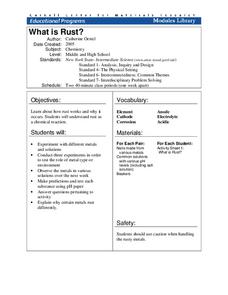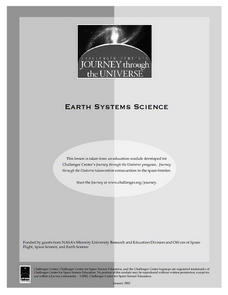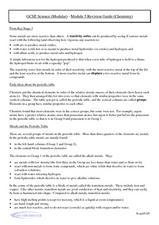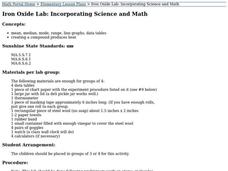Curated OER
Oxidation: Does Iron Burn?
Searching for a fairly easy demonstration of how oxidation triggers rust formation? The demonstration allows high school chemists to witness the rusting of metals, as large and small objects are held into a flame while triggering the...
Cornell University
What Is Rust?
Why do metals rust differently? Scholars experiment with metal combinations in a hands-on activity. They create unique environments with different metals and compare the rate and amount of rust for each.
Curated OER
Rusting-A Form of Oxidation
Young scholars conduct an experiment to observe oxidation. In this chemistry lesson, students explain how rusting happens. They rank metals according to their conductivity.
Curated OER
Rusting, Burning and Oxygen
In this rusting, burning and oxygen instructional activity, students read about chemical reactions and are given diagrams of a rusting bicycle, a burning candle, and a variety of chemical changes. Students make observations and explain...
Curated OER
Rusting as a Chemical Reaction
Learners participate in a hands-on activity in which they observe conditions that are most conducive to the rusting of iron. They set up an experiment with 8 different nails in different situations with one of them acting as a control....
Curated OER
Metals in Industry, Working with Metals
How is iron is extracted from it ore and then combined with other materials to produce steel? That question is answered in the presentation. Also covered is how titanium and aluminum are used in manufacturing. This is a compact lesson...
Curated OER
Rusting-A Form of Oxidation
Students observe the rusting process in the lab. In this chemistry lesson, students rank metals according to their conductivity. They give real world applications of this activity.
Curated OER
Corrosion & Rust
Students examine how and when rust and corrosion occur. In this corrosion lesson students complete an experiment to see why metals rust.
Curated OER
What's Eating Titanic?
Students, in groups, research the bio deterioration of the Titanic. They write a report focusing on the rusting of the Titanic and estimate the amount of time it will take for the Titanic's bow section to completely dissolve.
Curated OER
Oxidation of Iron - An Example of a Combination Reaction
Here are photos and general instructions for demonstrating two oxidation reactions with your physical science beginners. They use salt and hydrogen peroxide to cause iron filings to rust, and they combine hydrogen peroxide with a piece...
Curated OER
Rusting of Metals: Brown Village Roofs
Learners define iron rust and its formation. They demonstrate how iron rusting can be prevented.
Curated OER
Rust Never Sleeps
High schoolers investigate oxidation-reduction reactions involving iron by conducting an experiment in which they expose iron filings to different atmospheric and ocean conditions. They relate the results to the oxidation banding...
Curated OER
Rusting and the Scientific Method
Pupils observe the oil can scene with the tin man from a clip from "The Wizard of Oz" and answer the question, "What can we learn about rust from this scene?". They take 2 tubes and 2 nails, adding 1 salt packet to 2 ml of distilled...
Curated OER
Module 5 Revision Guide - Chemistry
If you use this as an outline for your chemistry lecture on metals, your young chemists will absorb a well-rounded overview. This is not a learning exercise per se, but a useful summary of the behavior of metals. Save yourself some...
Curated OER
Rusting: A Form of Oxidation
Students observe and record the corrosive nature of oxidation-reduction reactions, and determine the electro-chemical series of selected metals.
Curated OER
Choosing Materials for Bicycle Frames
In this materials for bicycle frames instructional activity, high schoolers read about the various materials that have been used to construct bicycles and the pros and cons of each. They answer four critical thinking questions about the...
Curated OER
Iron Oxide Lab: Incorporating Math and Science
Students conduct an experiment in small groups, draw conclusions about the amount heat of a compound achieves and practice their data analysis skills.
Curated OER
Weathering and Erosion
Students investigate how changes occur on the surface of the earth through erosion and glaciation. They observe what happens to salt and iron after they interact with water and vinegar, and analyze what occurs when water is sprinkled on...
Curated OER
Use of Common Metals
In this metals activity, students read about the different properties of aluminum, copper, and iron and determine why these metals are used they way they are used. This activity has 5 short answer questions.
Curated OER
WS 1.2 Metric Units I/ Physical vs. Chemical
In this metric units and properties learning exercise, students determine the proper metric unit given a variety of measurements for specific items. They also identify chemical and physical properties and chemical and physical changes.
Curated OER
Everest The Death Zone
Students watch a video about climbers on Mount Everest. In groups, they complete experiments in which they determine the concentration of oxygen in the air. They make predictions before beginning the experiment and complete a worksheet...
Curated OER
Ziplock Chemistry
Students investigate various chemical reactions when creating mixtures in ziplock baggies. In this chemistry lesson, students will recognize various chemical reactions and cite evidence. Safety and assessment strategies are included in...
Curated OER
Mars
After reading a short excerpt about the planet named after the Roman god of war, Mars, your class will answer four comprehension questions. The activity challenges them to fold over the paper and answer the questions without referring...
Virginia Department of Education
Matter and Energy: Equations and Formulas
Using simple materials, an informative lesson demonstrates the Law of Conservation of Matter and explains how to balance chemical equations. Young chemists perform experiments, analyze reactions, and balance chemical equations on their...

























